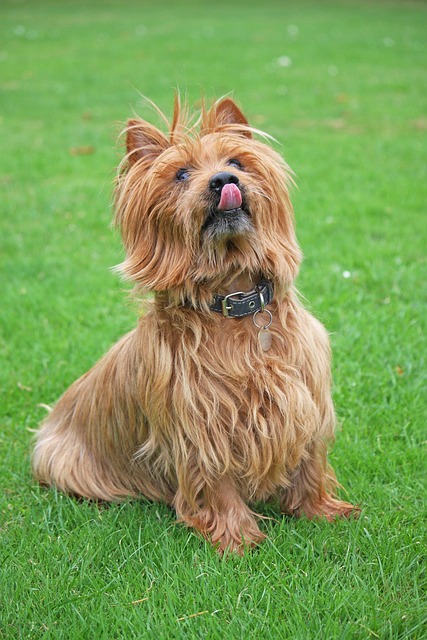


The Australian Terrier is a small, sturdy dog known for its spunky personality, intelligence, and rugged appearance. This breed is one of Australia's oldest native terriers and has been prized for its ability to hunt small game and protect farms. Despite their compact size, Australian Terriers are confident, courageous, and can be quite feisty, making them excellent companions for active individuals and families. They are known for their distinctive rough, wiry coat and lively demeanor, making them a unique and charming breed in the world of terriers.
The Australian Terrier was developed in Australia in the 19th century, primarily as a working dog to help control pests on farms and in the surrounding wilderness. The breed is believed to have descended from various terriers brought to Australia by early settlers, including the Skye Terrier, Cairn Terrier, and Dandie Dinmont Terrier. These dogs were used to hunt small game such as rodents, and their strong instincts made them excellent at protecting farmyards and homes. The Australian Terrier quickly became known for its courage, tenacity, and ability to adapt to various environments. It was recognized by the Australian National Kennel Council in the early 20th century and has since gained popularity as a companion dog, thanks to its affectionate nature and versatility.
The Australian Terrier is a small dog, typically weighing between 12 to 14 pounds and standing about 10 to 11 inches tall at the shoulder. Despite its small size, the breed has a sturdy and muscular build, giving it an alert and confident stance. One of the breed's most distinctive features is its rough, wiry coat, which is usually a mix of blue and tan or sandy in color. Their coats are dense and require regular grooming to keep them healthy and tangle-free. The Australian Terrier has a wedge-shaped head with a strong jaw, pointed ears, and expressive dark eyes that reflect its lively personality. Its tail is typically docked, and it is carried straight or slightly curved, adding to the breed's energetic appearance.
Australian Terriers are known for their bold and confident personalities. Despite their small size, they are fearless and will often act much larger than they are. They are loyal and affectionate with their families, but they can also be independent and sometimes stubborn. This breed tends to be alert and protective, making them good watchdogs. However, they are generally not aggressive and are usually friendly with strangers once properly introduced. Australian Terriers are good with children, especially if raised with them, and they can get along well with other dogs, though they may have a strong prey drive and should be monitored around small animals like rabbits or birds.
Despite their small size, Australian Terriers are active and require regular exercise to stay healthy and happy. They enjoy daily walks and benefit from time spent playing in a securely fenced yard where they can burn off energy. Australian Terriers are highly energetic and enjoy interactive play, such as fetch or tug-of-war. They also excel in dog sports, such as agility or obedience training, which provides both physical and mental stimulation. While they are adaptable to apartment living, they still require daily exercise to prevent boredom and maintain a healthy weight. Without enough exercise, they may become destructive or develop behavioral issues, so regular playtime and walks are essential.
Australian Terriers are intelligent dogs, but they can also be a bit independent and stubborn at times. Early socialization and consistent training are key to ensuring they develop into well-behaved pets. Positive reinforcement methods, such as using treats and praise, work best with this breed. Australian Terriers are eager to please their owners, but they may not always follow commands as quickly as other breeds. Patience and consistency in training are important. Socialization with other dogs, people, and environments should begin at an early age to prevent excessive territorial or aggressive behaviors. Proper training can help mitigate any potential behavioral challenges, such as barking or digging, which are common in terriers.
The Australian Terrier is generally a healthy breed, with a lifespan of around 12 to 15 years. Like all breeds, they can be prone to certain health issues, though many of these are manageable with proper care. Some common health concerns in Australian Terriers include hip dysplasia, patellar luxation, and skin allergies. Regular veterinary check-ups and a healthy diet are essential to keeping them in optimal health. Their wiry coats require regular grooming, typically every 4 to 6 weeks, to prevent matting and maintain their distinctive appearance. Brushing the coat a few times a week can also help reduce shedding. Additionally, Australian Terriers' ears should be cleaned regularly to prevent infections, and their nails should be trimmed regularly to prevent overgrowth.
The Australian Terrier has a lifespan of approximately 12 to 15 years, though some may live even longer with proper care. Regular veterinary visits, a balanced diet, and appropriate exercise all contribute to the breed's longevity. Since Australian Terriers are a relatively healthy breed, they can live long and happy lives with the right attention to their needs. They are generally robust, but being proactive about their health and managing potential hereditary issues can ensure they remain healthy throughout their lives.
© copyright Dog Compendium 2024 - 2025